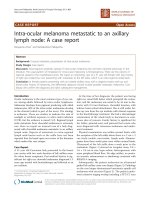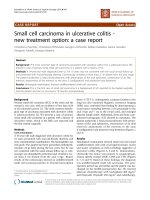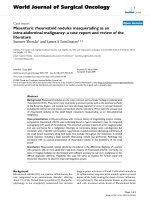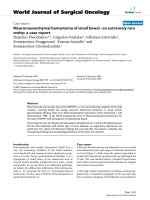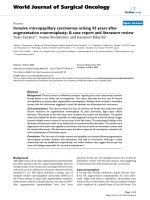Báo cáo khoa học: " Primary growth hormone insensitivity (Laron syndrome) and acquired hypothyroidism: a case report" doc
Bạn đang xem bản rút gọn của tài liệu. Xem và tải ngay bản đầy đủ của tài liệu tại đây (340.01 KB, 6 trang )
CAS E REP O R T Open Access
Primary growth hormone insensitivity
(Laron syndrome) and acquired hypothyroidism:
a case report
Oana R Cotta
1
, Libero Santarpia
2
, Lorenzo Curtò
1
, Gianluca Aimaretti
3
, Ginevra Corneli
4
, Francesco Trimarchi
1
and
Salvatore Cannavò
1*
Abstract
Introduction: Primary growth hormone resistance or growth hormone insensitivity syndrome, also known as Laron
syndrome, is a hereditary disease caused by deletions or different types of mutations in the growth hormone
receptor gene or by post-receptor defects. This disorde r is characterized by a clinical appearance of severe growth
hormone deficiency with high levels of circulating growth hormone in contrast to low serum insulin-like growth
factor 1 values.
Case presentation: We report the case of a 15-year-old Caucasian girl who was diagnosed with Silver-Russell
syndrome at the age of four and a half years. Recombinant growth hormone was administered for 18 mon ths
without an appropriate increase in growth velocity. At the age of seven years, her serum growth hormone levels
were high, and an insulin-like growth factor 1 generation test did not increase insulin-like growth factor 1 leve ls
(baseline insulin-like growth factor 1 levels, 52 μg/L; reference range, 75 μg/L to 365 μg/L; and peak, 76 μg/L and
50 μg/L after 12 and 84 hours, respectively, from baseline). The genetic analysis showed that the patient was
homozygous for the R217X mutation in the growth hormone receptor gene, which is characteristic of Laron
syndrome. On the basis of these results, the diagnosis of primary growth hormone insensiti vity syndrome was
made, and recombinant insulin-like growth factor 1 therapy was initia ted. The patient’s treatment was well
tolerated, but unexplained centr al hypothyroidism occurred at the age of 12.9 years. At the age of 15 years, when
the patient’s sexual development was almost completed and her menstrual cycle occurred irregularly, her height
was 129.8 cm, which is 4.71 standard deviations below the median for normal girls her age.
Conclusion: The most important functional tests for the diag nosis of growth hormone insensitivity are the insulin-
like growth factor 1 generation test and genetic analysis. Currently, the only effective treatment is daily
administration of recombinant insulin-like growth factor 1 starting from ea rly childhood. However, these patients
show a dramatically impaired final height. In our case , unexplained central hypothyroidism occurred during
treatment.
Introduction
Primary growth hormone (GH) insensitivity (Laron syn-
drome) includes a range of disorders with demonstrable
resistance to the action of GH. The classical GH insensi-
tivity syndrome (GHIS) is an autosomal, recessively
inherited form of dwarfism phenotypically resemb ling
GH deficiency, but differing from it by high levels of cir-
culating GH.
In 1966, the description of the first cases, three Yeme-
nite Jewish siblings, led to the discovery of the poly-
morphic defects of the GH receptor (GHR) which result
in the inability t o generate insulin-like growth factor 1
(IGF-1) [1]. Nowadays, this disorder has been reported
in more than 250 cases worldwide, being found mainly
in consanguineous families from Mediterranean, Middle
East ern, or South Asian r egions or in their descendants,
including a large cohort identified in southern Ecuador
* Correspondence:
1
Department of Medicine and Pharmacology, University of Messina, Messina,
Italy
Full list of author information is available at the end of the article
Cotta et al. Journal of Medical Case Reports 2011, 5:301
/>JOURNAL OF MEDICAL
CASE REPORTS
© 2011 Cotta et al; licensee BioMed Central Ltd. This is an Open Access article distributed under the terms of the Creative Commons
Attribution License (http: //creativecommons.org/licenses/by/2.0), which permits unrestricted use, distribution, and reproduction in
any mediu m, provided the original work is properly cited.
who are c onsidered to be desc endants o f converso s
(Spanish Jews who became Catholic during the Inquisi-
tion) [2]. To date, more than 70 unique GHR mutations
have been identified in more than 250 GHIS patie nts.
These include missense or non-sense mutations, splice
site mutations, and insertions or deletio ns [3,4], and t he
vast majority of the point mutations have compromised
the extracellular domain. These mutations are almost all
recessively inherited in either homozygous or compound
heterozygous form.
We present the outcome of eight-year recombinant
IGF-1 (rIGF-1) replacement in a girl with Laron type
dwarfism cause d by an R217X mutation of the gene
encoding for GHR, who developed hypothyroidism dur-
ing treatment.
Case presentation
A 13-year-old Caucasian girl was referred to our unit for
the follow-up of Laron-type dwarfism diagnosed six
years earlier. She wa s the second child of a Sicilian
family of second-degree cousins. Both parents’ heights
were in the normal range: her father was 178 cm tall,
and h er mother was 160 cm tall, and they were 37 and
31 years old, respectively, at the time of conception. As
the product of a 36-week, uneventful gestation and
delivery, the patient was born with normal birth weight
andsize.Failuretothrivebecameevidentafterthefirst
year of life, when both her height (61 cm, -7.06 standard
deviations (SDs)) and weight ( 6610 g) were well below
the third percentile. Her head circumference (45 cm)
was in the third percentile but appeared disproportion-
ally large for her b ody. The frontal fontanel was open
(1.5 cm × 1.5 cm), and pale skin, frontal bossing, blue
sclera, a hypoplastic nasal bridge, obesity, and an
increased upper-to-lower segment ratio were also noted.
No hypoglycemic episode had been reported. Her rou-
tine blood analysis results were normal. Karyotype ana-
lysis revealed a normal, 46, XX female, and wrist
radiography documented delayed bone maturation.
At the age of three and a half years, she underwent an
endocrine evaluation in a pediatric center. Her baseline
serum GH leve ls were 6 ng/mL and peaked at 8.5 ng/
mL during a clonidine test (150 mg/m
2
,orally).Her
serum IGF-1 values were very low (31 ng/mL and 82.9
ng/mL on two different days; reference range, 100 ng/
mL to 500 ng/mL). Magnetic resonance imaging (MRI)
showed a hypoplastic pituitary gland (images not avail-
able). At the age of four and a half years, she was diag-
nosed with Silver-Russell syndrome, and recombinant
GH (rGH) was administered for 18 months without an
appropriate increase in height velocity (3.5 cm/year,
-3.20SD).
She was reevaluated at the age of seven years in an
endocrine unit in another Italian city. Her serum GH
level was high (26.8 ng/mL, representing the mean of
three determinations during the same morning). An
IGF-1 generation test (rGH, 0.03 mg/kg for four conse-
cutive evenings) did not increase her IGF-1 levels (base-
line IGF-1 level, 52 μ g/L; reference range, 75 μg/L to
365 μg/L; peak, 76 μg/L and 50 μg/L after 12 and 84
hour s, respectively, from the baseline). The genetic ana-
lysis showed that the patient was homozygous for the
R217X mutation o f the GHR gene [5 ], which is charac-
teristic in patients with Laron syndrome. On the basis
of these results, the diagnosis of primary GHIS was
made and rIGF-1 therapy was initiated when she was
seven and a half years of age. During the first year of
treatment, her growth velocity showed a twofold
increase. However, she did not experience appropriate
catch-up growth, a nd at the age of 15 years, her height
was 129.8 cm, 4.71SDs below the median for normal
height (Figure 1). The s tarting dose of rIGF-1 was 50
μg/kg twice daily, and the dose was titrated according to
GH and IGF-1 levels to a maximum dose of 120 μg/kg
twice daily. Treatment was administered continuously
until she was 13 and a half years of age, when her treat-
ment was withdrawn because of drug unavailability for
approximately six months. To date, our patient is still in
therapy. She r eported no adverse effects, no hypoglyce-
mic episodes occurred, and she did not experience
arthralgia, myalgia, or skeletal pain. Periodic evaluation
excluded intra-cranial hypertension. An otorhinolaryn-
gologic evaluation revea led the presence of tonsillar and
adenoidal hypertrophy after approximately eight years of
rIGF-1 therapy.
At the age of 12.9 year s, when she was referred to us,
an endocrinologic evaluation showed a low serum-free
thyroxine (FT4) level (9.96 pmol/L; reference range, 12
pmol/L to 22 pmol/L). H er serum-free triiodothyronine
(FT3) level (4.71 pmol/L; reference range, 3.0 pmol/L to
6.8 pmol/L) and thyroid-stimulating hormone (TSH)
level (1.370 μIU/mL) were within the reference ranges.
Previously, the patient’ s thyroid function had always
been normal. Her test results for serum levels of thyroid
peroxidase and thyroglobulin antibodies had always
been negative. Thyroid ultrasonography showed a
reduced thyroid size (right lobe tran sverse diameter
(TD) 11 mm and anteroposterior diameter (APD) 13
mm; left lobe TD 10 mm and APD 9 mm) with normal
echotexture and without thyroid nodules. She was pre-
scribed levothyroxine (LT4) therapy (1.25 μg/kg/day),
which resulted in normaliza tion of her FT4 levels (12.07
pmol/L) and simultaneous suppressio n of TSH values
(0.3 μIU/mL). Exogenous thyrotropin-releasing hormone
administration (200 μg intravenously) induced a normal
TSH response (peak at 20 minutes, 12.8 μIU/mL. An
MRI study of her pituitary excluded any organic reason
for central hypothyroid ism. Puberty started six months
Cotta et al. Journal of Medical Case Reports 2011, 5:301
/>Page 2 of 6
later, and menarche occurred when she was 14.3 years
of age. At the age of 15 years, the patient’s sexual devel-
opment was almost completed (Tanner stage 4), and her
menstrual cycle occurred irregularly.
Discussion
Our patient has a typical case of Laron syndrome pre-
senting with a classical GHIS phenotype and laboratory
findings, but unfortunately was diagnosed and therefore
treated at a late age. Clinically, patients with GHIS pre-
sent in a manner virtually indistinguishable from those
with severe GH deficiency. Birth weight and length are
likely to be within the reference ranges, but post-natal
linear growth is strikingly abnormal with a rapid decline
in growth velocity soon after birth. The natural hist ory,
without proper treatment, results in an extremely short
adult stature ranging between 4 and 10 SDs below the
median for normal height [6]. Relative obesity is present
at birth and increases with age, with a relative excess of
adipose tissue in the context of thin bones and dimin-
ished muscular mass. The up per-to-lower s egment ratio
is increased with regard to sex and chronologic age,
denoting short li mbs for trunk size. Conge nital malfor-
mations, craniofacial abnormalities, and other physical
features may be noted at birth. Facial bone growth is
particularly retarded, and fontanel closure is delayed,
leading to a disproportionate cephalofacial relationship
because of the decreased vertical dimension of the face,
with frontal bossing, a saddle nose, shallow orbits, and
the setting sun sign of the eyes. Blue s clera may be
noted , particularly in patients of Mediterranean or Mid-
dle Eastern origin. Hair growth is quite sparse in infancy
and through early childhood. I t is silky and forms tem-
poral and frontal recessions. Tooth development is
delayed, and the teeth may often be defective. The lar-
ynx is narrow, resulting in a very high-pitched voice.
The genital ia and gonads are small from birth. Pubertal
development is delayed, and the pubertal growth spurt
is absent, but adult sexual maturation is eventually
achieved. Walking and other gross motor developm ental
milestones are delayed because of the underdeveloped
musculature. The hands and feet are s mall (acromi cria).
Hip dysplasia, notably avascular necrosis of the femoral
head, has been reported in up to 25% of patients [2].
The skin is thin and has a fine texture with wrinkles as
in premature aging. Cardiological investigations and pul-
monary function studies have revealed cardiomicria,
reduced width of the cardiac muscle, reduced left ventri-
cular output, and reduced maximal aerobic capaci ty [7].
Psychological evaluations suggest a great variability in
intellectual development, ranging from normal intelli-
gence to severe mental retardation [3].
The cardinal biochemical features of GHIS are low
levels of all GH-dependent proteins, including very low
or even undetectable serum IGF-1 levels, IGF binding
protein 3, and acid labile subunit in association with
rIGF-1
Age (years
)
H
eight (cm)
+ 2 SD
-2 SD
MEAN
3° percentil
e
Figure 1 Growth chart of our patient with primary growth hormone insensitivity syndrome (red line) before and during recombinant
insulin-like growth factor 1 therapy. (Reproduced with permission from Laron et al. [6].)
Cotta et al. Journal of Medical Case Reports 2011, 5:301
/>Page 3 of 6
normal or increased GH levels. The regulation of GH
secretion and feedback mechanisms is normal. The
most important functional test for the diagnosis is the
IGF-1 generation test because serum IGF-1 levels are
low and do not increase with the administration of exo-
genous rGH for days or weeks, demonstrating the state
of GH resistance in these patients [3]. Metabolic
abnormalities include fasting hypoglycemia and
hypercholesterolemia.
The underlying metabolic defect lies in the lack of
responsiveness of the t arget organs to endogenous GH.
In 1984, it was proven by liver biopsy that GH does not
bind to its receptors and therefore is unable to generate
IGF-1 [8]. T his explains why patients with primary
GHIS typically have low to undetectable serum levels of
IGF-1, even though serum GH levels are normal or
high. In addition, exogenous rGH fails to accelera te
growth or to stimulate serum IGF-1 levels or IGF bind-
ing protein 3 [3]. At the age of four and a half years,
our patient had been treated with rGH for a period of
18 months, but this therapy did not appropriately
increase her growth velocity.
The only effective treatment is the daily administra-
tion of rIGF-1 starting from early childhood and prob-
ably throughout life. The rIGF-1 treatment accelerates
linear growth velocity, and appropriate dose titrating
results in tripling of the baseline growth rate during the
first year of treatment [9]. Even if these patients may
never experience sufficient catch-up growth to bring
their height within the normal range, they do achieve an
adult height significantly greater than expected in the
absence of therapy [9]. The main reasons could be, on
the one hand, the inability to replicate physiological
IGF-1 distribution and action and, on the other hand,
the i nability to restore GH defects, because animal stu-
dies indicate that GH has growth-promoting effects
apart from the IGFs [10].
Evidence exists that rIGF-1 therapy also reduces body
fat, stimulates kidney function, and maintains left ventri-
cle dimension and function within the normal range of
age-matched control subjects [11].
Hypoglycemia is the most frequent side effect,
observed both before and during therapy and reported
in as many as 50% of cases. Lymphoid tissue hypertro-
phy associated with hypoacusis and snoring occurs in
approximately 22% of treated patients, and tonsillar or
adenoidal hypertrophy requiring tonsillectomy or ade-
noidectomy has been seen in 10% of cases. Several cas es
of intra-cranial hypertension or papilledema have been
observed. Increa sed growth of the internal organs,
which was a main concern before long-term trials were
conducted, has been reported but with no clinical
impact, because this effect waned over time. Acromega-
loid coarsening of the face has also been reported in a
number of patients, particularly those of pubertal age
[9].
Our patient has been treated with rIGF-1 for approxi-
mately eight years, but she has not experienced enough
catch-up growth to bring her height into the normal
range. At the age of 15 years, she was 129.8 cm tall,
which is 4.71 SDs below the median for normal height
at her age. Except for tonsillar and adenoidal hypertro-
phy, no other known side effect has been reported.
The present knowledge of the effects of GH and IGF-1
def iciency on aging and lifespan suggests that untreated
patients w ith congenital isolated IGF-1 deficiency seem
to reach old age despite marked obesity, de velopment of
hyperlipidemia, and a tendency to develop diabetes and
its complications, probably because the risk for cancer, a
frequent cause of death in the general population, seems
to be reduced in these patients [12].
Genetic analysis showed that our patient is homozy-
gous for the R217X mutation in the GHR gene (homo-
zygous C to T transition in exon 7 causing CGA to
TGA substitution at codon 7) [5]. The molecular defect
occurs in the extracellular domain of the GHR and
leads t o a premature terminat ion signal and a trunca ted
non-functional receptor.
This particular mutation has been reported previously
in several patients from countries located in the Medi-
terranean and Middle Eastern region, as well as in
North America [4,13]. The R217X mutation has been
linked to the develo pment of type 2 diabetes mellitus
complicated by diabetic retinopathy in a patient with
Laron-type dwarfism who had never been trea ted with
rIGF-1 [14]. The patient had background diabetic reti-
nopathy and progressively developed exudates, microa-
neurysms, hemorrhages, and clinically significant
macular edema. He also had subacute ischemic heart
disease. This suggests that congenital IGF-I deficiency,
similar to excess, may cause vascular complications of
diabetes mellitus, also de noting that vascular endothelial
growth factor can induce neovascularization in the pre-
sence of congenital IGF-I deficiency [14].
At the age of 12.9 years, our patient suddenly dev el-
oped hypothyroidism. Both low levels of FT4 associated
with normal TSH levels present at diagnosis and TSH
suppress ion after a relatively low LT4 dose per kilogram
reinforced the hypothesis of central hypothyroidism.
It seems unlikely that her hypothyroidism was induced
by rIGF-1 therapy. In support of this theory is the fact
that during r IGF-1 treatment withdrawal for approxi-
mately six months, the patient’s thyroid function did not
improve. During that time, we also performed LT4 with-
drawal, which did not result in an increase in FT4. Our
finding is in agreement with that of Klinger et al. [15],
who previously showed that rIGF-1 therapy does not
cause abnormal thyroid function.
Cotta et al. Journal of Medical Case Reports 2011, 5:301
/>Page 4 of 6
To the best of our knowledge, this is the first report of
a case of GHIS associated with hypothyroidism. It
remains to be seen whether there is any association with
GHIS or whether it is an isolated case.
Conclusions
Primary GH resistance or GHIS, also known as Laron
syndrome, is a hereditary disease caused by deletions or
mutations in the GHR gene or the post-receptor
mechanisms. These polymorphic defects lead to the
inability to generate IGF-1, which is the anabolic effec-
tor of GH. The early and continuous IGF-1 deficiency
causes dwarfism as well as skeletal and muscular
underdevelopment.
Daily administration of rIGF-1 is effective in promot-
ing catch-up growth and is safe. However, no data are
available concerning treatment througho ut life. An early
correct diagnosis of this sy ndrome is crucial for appro-
priate preventive care and therapy.
Patient’s perspective
“I am a 15-year-old girl and for the last 10 years of my
life, twice daily, I am given an injec tion that is supposed
to help me grow and make up for the height difference
that distinguishes me from the other girls my age. I can-
not consider myself too satisfied by this therapy, because
I did not get the results I was hoping for, but on the
other hand I realize that this drug is my only c hance to
gain height.
“ I have always been taken care of by fine doctors.
They helped me a lot and I take this chance to thank
them all, both doctors from Turin as well as from
Messina.
“As far as my daily life is concerned, I can say that,
despite everything, I have no problems interacting with
my friends. They appreciate me for who I am, because
both from a psychological and intellectual point of view
I honestly do not think I have any difficulties. My
strength relies in my strong character and in the fact
that, I am aware that there are many other children who
have problems, probably more serious than mine.
“For the future I hope that research, based also on real
life experience, can progress and help all chi ldren born
with my same problem.”
Consent
Written informed consent was obtained from the
patient’s father for publication of this case report and
any accompanying images.
Abbreviations
APD: anteroposterior diameter; FT3: free triiodothyronine; FT4: free thyroxine;
GH: growth hormone; GHIS: growth hormone insensitivity syndrome; GHR:
growth hormone receptor; IGF-1: insulin-like growth factor 1; LT4:
levothyroxine; MRI: magnetic resonance imaging; rGH: recombinant growth
hormone; rIGF-1: recombinant insulin-like growth factor 1; TD: transversal
diameter; TSH: thyroid-stimulating hormone.
Author details
1
Department of Medicine and Pharmacology, University of Messina, Messina,
Italy.
2
Translational Research Unit, Department of Oncology Hospital of Prato
and Istituto Toscano Tumori, Firenze, Italy.
3
Endocrinology, Department of
Experimental and Clinical Medicine, University A. Avogadro del Piemonte
Orientale, Novara, Italy.
4
Division of Endocrinology and Metabolism,
Department of Internal Medicine, University of Turin, Turin, Italy.
Authors’ contributions
All authors contributed to the management of the patient. In addition, ORC
collected data regarding the patient and wrote the manuscript. LS and LC
reviewed the literature concerning the case. FT was a major contributor to
the writing of the manuscript. SC analyzed the data and supervised the
editing of the manuscript. All authors read and approved the final
manuscript.
Competing interests
The authors declare that they have no competing interests.
Received: 26 October 2009 Accepted: 11 July 2011
Published: 11 July 2011
References
1. Laron Z, Pertzelan A, Mannheimer S: Genetic pituitary dwarfism with high
serum concentration of growth hormone: a new inborn error of
metabolism? Isr J Med Sci 1966, 2:152-155.
2. Rosenbloom AL, Guevara-Aguirre J, Rosenfeld RG, Francke U: Growth
hormone receptor deficiency in Ecuador. J Clin Endocrinol Metab 1999,
84:4436-4443.
3. Laron Z: Laron syndrome (primary growth hormone resistance or
insensitivity): the personal experience 1958-2003. J Clin Endocrinol Metab
2004, 89:1031-1044.
4. Savage MO, Attie KM, David A, Metherell LA, Clark AJ, Camacho-Hübner C:
Endocrine assessment, molecular characterization and treatment of
growth hormone insensitivity disorders. Nat Clin Pract Endocrinol Metab
2006, 2:395-407.
5. Fassone L, Corneli G, Bellone S, Camacho-Hübner C, Aimaretti G, Cappa M,
Ubertini G, Bona G: Growth hormone receptor gene mutations in two
Italian patients with Laron syndrome. J Endocrinol Invest 2007, 30:417-420.
6. Laron Z, Lilos P, Klinger B: Growth curves for Laron syndrome. Arch Dis
Child 1993, 68:768-770.
7. Ben-Dov I, Gaides M, Scheinowitz M, Wagner R, Laron Z: Reduced exercise
capacity in untreated adults with primary growth hormone resistance
(Laron syndrome). Clin Endocrinol (Oxf) 2003, 59:763-767.
8. Eshet R, Laron Z, Pertzelan A, Dintzman M: Defect of human growth
hormone in the liver of two patients with Laron type dwarfism. Isr J Med
Sci 1984, 20:8-11.
9. Chernausek SD, Backeljauw PF, Frane J, Kuntze J, Underwood LE, GH
Insensitivity Syndrome Collaborative Group: Long-term treatment with
recombinant insulin-like growth factor (IGF)-I in children with severe
IGF-I deficiency due to growth hormone insensitivity. J Clin Endocrinol
Metab 2007, 3:902-910.
10. Lupu F, Terwilliger JD, Lee K, Segre GV, Efstratiadis A: Roles of growth
hormone and insulin-like growth factor 1 in mouse postnatal growth.
Dev Biol 2001, 229:141-162.
11. Scheinowitz M, Feinberg MS, Laron Z: IGF-I replacement therapy in
children with congenital IGF-I deficiency (Laron syndrome) maintains
heart dimension and function. Growth Horm IGF Res 2009, 19:280-282.
12. Laron Z: The GH-IGF1 axis and longevity: the paradigm of IGF1
deficiency. Hormones 2008, 7:24-27.
13. Berg MA, Argente J, Chernausek S, Gracia R, Guevara-Aguirre J, Hopp M,
Pérez-Jurado L, Rosenbloom A, Toledo SP, Francke U: Diverse growth
hormone receptor gene mutations in Laron syndrome. Am J Hum Genet
1993, 52:998-1005.
14. Laron Z, Weinberger D: Diabetic retinopathy in two patients with
congenital IGF-I deficiency (Laron syndrome).
Eur J Endocrinol 2004,
151:103-106.
Cotta et al. Journal of Medical Case Reports 2011, 5:301
/>Page 5 of 6
15. Klinger B, Ionesco A, Anin S, Laron Z: Effect of insulin-like growth factor I
on the thyroid axis in patients with Laron-type dwarfism and healthy
subjects. Acta Endocrinol (Copenh) 1992, 127:515-519.
doi:10.1186/1752-1947-5-301
Cite this article as: Cotta et al.: Primary growth hormone insensitivity
(Laron syndrome) and acquired hypothyroidism: a case report. Journal
of Medical Case Reports 2011 5:301.
Submit your next manuscript to BioMed Central
and take full advantage of:
• Convenient online submission
• Thorough peer review
• No space constraints or color figure charges
• Immediate publication on acceptance
• Inclusion in PubMed, CAS, Scopus and Google Scholar
• Research which is freely available for redistribution
Submit your manuscript at
www.biomedcentral.com/submit
Cotta et al. Journal of Medical Case Reports 2011, 5:301
/>Page 6 of 6
